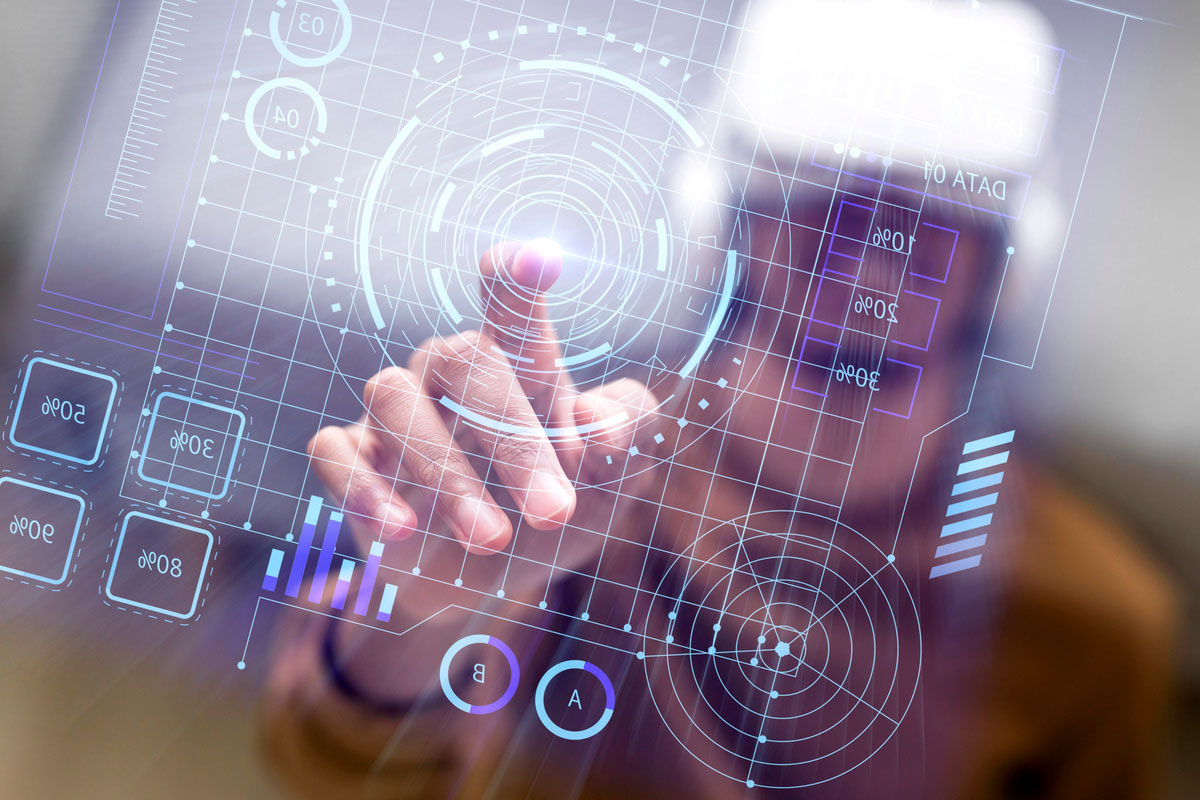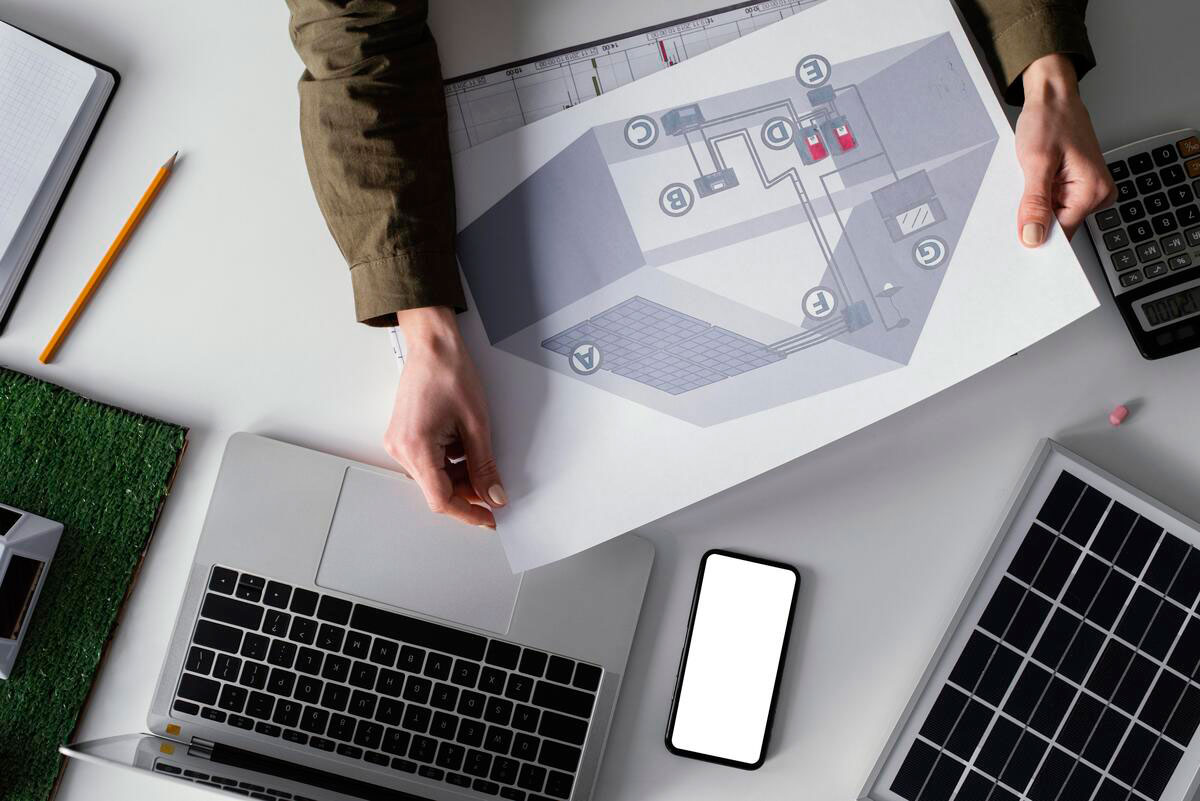Exclusive Neuroject Article: Building digitalization represents a transformative shift in the construction industry, leveraging advanced technologies to revolutionize project management, design, execution, and maintenance. This evolution, propelled by digital tools like Building Information Modeling (BIM), Artificial Intelligence (AI), and the Internet of Things (IoT), fosters efficiency, precision, and sustainability across the entire construction lifecycle.
Integrating these digital technologies has proven instrumental in enhancing project outcomes. For instance, statistics reveal that BIM implementation can yield remarkable results, with a reported 75% decrease in project schedule delays and a notable 30% reduction in overall project costs. Similarly, IoT applications on construction sites have demonstrated their impact, with studies indicating up to 25% savings in energy consumption and a 30% decrease in equipment downtime through predictive maintenance.
This digital revolution begins with the design phase, where BIM enables detailed 3D modeling and simulations, allowing stakeholders to identify potential clashes and errors before construction commences. As projects progress, AI-driven analytics offer predictive insights, optimizing resource allocation and mitigating risks. Moreover, IoT sensors monitor real-time conditions, facilitating data-driven decision-making and ensuring compliance with sustainability goals.
By leveraging building digitalization, the construction industry is reshaping traditional practices, emphasizing precision, quality assurance, and adherence to sustainability standards. This overview highlights how digital tools, powered by data and innovation, lead to streamlined processes, cost efficiencies, and superior project outcomes, setting the stage for a more dynamic and sustainable future in construction.
Table of Contents
What is Building Digitalization?
Building digitalization refers to the comprehensive transformation of the construction industry through the integration of advanced digital technologies and processes across all phases of a building’s lifecycle. It encompasses the utilization of innovative tools such as Building Information Modeling (BIM), Internet of Things (IoT), Artificial Intelligence (AI), robotics, and other digital platforms to streamline and optimize every aspect of construction projects, from planning and design to construction, operation, and maintenance.
At its core, building digitalization aims to revolutionize traditional construction practices by digitizing and centralizing data, enabling seamless collaboration among various stakeholders, enhancing efficiency, and improving project outcomes. It enables the creation of a digital twin—a virtual replica of the physical building—facilitating real-time monitoring, analysis, and simulation to optimize performance and maintenance throughout the building’s lifecycle.
One of the fundamental aspects of building digitalization is Building Information Modeling (BIM), which serves as a central hub for storing and managing detailed 3D models and relevant project information. BIM enables multidisciplinary teams to work collaboratively, providing a holistic view of the project and aiding in better decision-making by identifying and mitigating potential issues before they arise.
Moreover, the integration of IoT devices within buildings allows for the collection of vast amounts of real-time data from sensors embedded in construction materials, equipment, and structures. This data empowers stakeholders to monitor building conditions, energy usage, occupancy patterns, and maintenance needs, leading to more informed decisions and proactive actions.
Artificial Intelligence and machine learning algorithms play a crucial role in building digitalization by analyzing immense datasets, predicting potential issues, optimizing resource allocation, and automating various processes. Additionally, robotics and automation are transforming construction sites by performing labor-intensive tasks with precision and speed, reducing manual labor requirements and enhancing safety.
Overall, building digitalization is not merely about adopting new technologies; it’s a fundamental shift in how the construction industry operates. It’s about embracing innovation to create smarter, more sustainable, and more efficient buildings while improving collaboration, reducing costs, and delivering higher-quality projects that meet the evolving demands of modern society.

Why is Building Digitalization Crucial?
Digitalization holds immense significance in various industries, including construction, due to several compelling reasons:
1. Efficiency Amplification
Building Digitalization optimizes workflows by automating repetitive tasks and providing streamlined processes. This efficiency extends across project phases, from design and planning to execution and maintenance. For instance, tools like BIM allow for the visualization of the entire project, identifying potential clashes and issues before they occur, saving time and resources.
2. Seamless Collaboration
Centralized digital platforms enable real-time collaboration among dispersed teams and stakeholders. With cloud-based systems and collaborative tools, information sharing becomes instantaneous, facilitating collective decision-making, reducing communication gaps, and enhancing project coordination.
3. Cost Optimization
By eliminating inefficiencies, building digitalization inherently leads to cost savings. Predictive analytics help in precise resource allocation, reducing material waste, and minimizing rework. Proactive maintenance based on data analysis prevents costly breakdowns, enhancing the longevity of infrastructure.
4. Precision and Quality Assurance
Digital tools ensure accuracy in design and construction, mitigating errors and inconsistencies. This precision leads to higher-quality outputs, ensuring that projects meet or exceed industry standards and client expectations.
5. Innovation and Adaptability
Embracing building digitalization encourages the adoption of innovative technologies and methodologies. This fosters adaptability, enabling the industry to respond to evolving trends, market demands, and technological advancements.
6. Data-Driven Decision-Making
Access to vast amounts of data and analytics provides invaluable insights. Predictive analysis and risk assessments enable proactive decision-making, identifying potential challenges early and offering informed solutions.
7. Sustainability and Environment
Building digitalization promotes eco-friendly construction practices. Through energy optimization, waste reduction, and lifecycle assessments facilitated by digital tools, the industry can minimize its environmental footprint and create more sustainable structures.
8. Resilience and Future Preparedness
A digitally equipped industry is better prepared to handle future challenges. The ability to adapt, innovate, and leverage technology ensures the development of resilient infrastructure capable of withstanding unforeseen disruptions or changes.
9. Customer-Centric Approaches
Building Digitalization enables more client-centric approaches by allowing for increased transparency, clearer communication, and the ability to visualize and understand projects better. Clients can have more involvement and confidence in project outcomes.
10. Global Connectivity and Accessibility
Digital platforms enable global connectivity and accessibility. Remote collaboration, access to expertise from anywhere, and the sharing of best practices contribute to a more connected and informed global construction community.
Building digitalization isn’t just a technological upgrade; it’s a fundamental shift in how the construction industry operates and approaches projects. Its impact spans from efficiency gains and cost-effectiveness to innovation, sustainability, and resilience. Ultimately, it empowers the industry to evolve, adapt, and deliver projects that meet the challenges of today while preparing for those of tomorrow.
In essence, building digitalization is crucial as it not only revolutionizes traditional practices but also empowers the construction industry to innovate, collaborate effectively, and deliver projects more efficiently while addressing contemporary challenges and future needs. It’s a transformative force that drives efficiency, quality, sustainability, and adaptability, positioning the industry for continued growth and advancement.
How does Building Digitalization Revolutionize Workflows?
Building digitalization revolutionizes workflows by integrating automation and streamlining processes across all stages of a construction project.
Design and Planning
In the initial stages, digital tools such as Building Information Modeling (BIM) enable comprehensive visualization of the entire project. Architects, engineers, and stakeholders can collaborate on a shared virtual model, identifying potential clashes or discrepancies in designs before construction begins. This proactive approach helps prevent costly errors and rework, saving significant time and resources.
Execution and Construction
During the execution phase, building digitalization facilitates precision and efficiency. Automated systems and robotics streamline repetitive tasks, enhancing accuracy and reducing manual labor requirements. Real-time data from IoT sensors and devices on the construction site provide insights into progress, material inventory, and safety conditions, allowing for swift decision-making and problem-solving.
Maintenance and Operations
Post-construction, building digitalization continues to add value by optimizing maintenance and operations. Predictive maintenance, powered by data analytics and AI, anticipates equipment failures or maintenance needs before they occur, preventing costly downtimes and extending the lifespan of assets. Digital records and documentation aid in efficient facility management and ongoing improvements.
Collaboration and Communication
Throughout the project lifecycle, digital platforms facilitate seamless collaboration and communication. Cloud-based tools allow stakeholders to access and share project data instantly, ensuring everyone remains on the same page. This real-time collaboration enhances coordination, minimizes misunderstandings, and expedites decision-making processes.
Risk Mitigation and Project Efficiency
Building digitalization’s ability to identify and address potential clashes or issues before they materialize minimizes risks and improves project efficiency. Early detection of conflicts in design or construction enables proactive resolutions, preventing delays and cost overruns.
In essence, building digitalization’s impact is comprehensive and transformative, optimizing workflows by integrating technology, automation, and data-driven decision-making across every stage of a construction project. It not only saves time and resources but also enhances precision, collaboration, and overall project success.

How does Building Digitalization have an Impact on Cost Optimization?
Cost optimization through building digitalization is a fundamental benefit that positively impacts various aspects of construction projects:
Precise Resource Allocation
Digital tools enable accurate resource allocation by leveraging predictive analytics and historical data. Through sophisticated algorithms, these tools forecast material requirements and resource needs with greater precision. This reduces excess inventory, minimizes waste, and ensures the efficient utilization of resources, consequently lowering overall project costs.
Minimized Rework and Errors
Early detection of clashes or errors in the design phase, facilitated by technologies like BIM, significantly reduces the likelihood of rework during construction. By identifying and rectifying issues before physical work begins, costly on-site modifications or alterations are minimized. This leads to substantial savings in both time and expenses associated with re-doing tasks.
Proactive Maintenance and Longevity
Building digitalization enables proactive maintenance strategies based on data analysis and IoT sensors. Predictive maintenance models predict equipment failures or potential issues, allowing for timely interventions. By addressing maintenance needs before they escalate into costly breakdowns, this approach significantly reduces downtime, and repair costs, and extends the lifespan of infrastructure assets.
Efficient Lifecycle Management
Throughout a building’s lifecycle, digital tools facilitate efficient management. From tracking asset performance to analyzing energy consumption patterns, data-driven insights aid in optimizing operational costs. This approach ensures that ongoing operational expenses are managed effectively, contributing to long-term cost savings.
Streamlined Project Management
Digital project management tools centralize project data and facilitate streamlined workflows. Real-time updates, automated reporting, and enhanced communication among stakeholders lead to more efficient project management. This streamlined process helps prevent delays, cost overruns, and discrepancies in project budgets.
Cost Transparency and Control
Building digitalization provides greater transparency and control over project costs. Detailed data analytics and reporting functionalities allow for better cost-tracking and control mechanisms. This transparency enables stakeholders to identify cost drivers, make informed decisions, and optimize spending throughout the project lifecycle.
In summary, building digitalization’s impact on cost optimization is multifaceted, ranging from precise resource management and minimized rework to proactive maintenance strategies. By leveraging data-driven insights and advanced technologies, the construction industry can significantly reduce unnecessary expenses, enhance efficiency, and ensure better cost control across projects.
Suggested article to read: How To Reduce Construction Cost
The Impact of Building Digitalization on Sustainability
Building digitalization is a catalyst for driving sustainable practices within the construction industry, fostering a positive impact on the environment:
Energy Optimization
Digital tools offer comprehensive insights into energy consumption patterns and efficiency. Through simulations and analysis, these tools optimize building designs and operations to minimize energy usage. They enable the integration of renewable energy sources, efficient HVAC systems, and smart lighting, contributing to reduced energy consumption and lower carbon emissions.
Waste Reduction and Material Efficiency
By leveraging data analytics and BIM, construction projects can optimize material usage and reduce waste. Accurate modeling and planning minimize over-ordering of materials, reduce excess inventory, and enable precise cutting and utilization of resources, thereby minimizing construction waste. Additionally, prefabrication and modular construction techniques, facilitated by building digitalization, contribute to more efficient material use and reduced on-site waste.
Lifecycle Assessments and Sustainable Design
Digital tools enable comprehensive lifecycle assessments of buildings. They assess environmental impacts from the extraction of raw materials to construction, operation, and eventual demolition or recycling. This holistic view aids in designing structures that are environmentally friendly throughout their lifecycle. Sustainable design principles, including considerations for recyclability, reuse of materials, and energy efficiency, are integrated into the construction process.
Environmental Monitoring and Compliance
Building digitalization facilitates real-time monitoring of environmental parameters. IoT sensors can track air quality, water usage, and other environmental factors, ensuring compliance with sustainability standards and regulations. This data-driven approach allows for immediate corrective actions if environmental parameters deviate from acceptable levels.
Green Certifications and Standards
Digital tools assist in achieving and maintaining green certifications such as LEED (Leadership in Energy and Environmental Design) or BREEAM (Building Research Establishment Environmental Assessment Method). These certifications validate and quantify the sustainability aspects of buildings, promoting environmentally responsible construction practices.
Community Engagement and Awareness
Digital platforms aid in communicating sustainability initiatives and engaging stakeholders. They facilitate transparent communication about green practices implemented in construction projects, fostering awareness and encouraging community involvement in sustainable initiatives.
In summary, building digitalization’s role in sustainability within the construction industry is pivotal. By optimizing energy usage, reducing waste, facilitating sustainable design, and ensuring compliance with environmental standards, digital tools contribute significantly to creating more eco-friendly and sustainable structures while minimizing the industry’s environmental footprint.

Precision and Quality Assurance in Building Digitalization
The integration of digital tools in the construction industry plays a pivotal role in ensuring precision and maintaining high-quality standards throughout the project lifecycle:
Accurate Design Visualization
Digital tools, especially Building Information Modeling (BIM), enable the creation of highly detailed and accurate digital representations of buildings and infrastructure. This visual representation helps stakeholders visualize the project comprehensively, ensuring a clear understanding of design intent and minimizing misinterpretations.
Error Identification and Resolution
Through advanced simulations and clash detection capabilities within BIM, potential design clashes and errors are identified in the pre-construction phase. This proactive approach allows for early detection and resolution of conflicts between architectural, structural, and MEP (mechanical, electrical, plumbing) elements, minimizing errors before construction begins.
Enhanced Collaboration and Communication
Digital platforms facilitate seamless collaboration among multidisciplinary teams. This fosters effective communication and coordination, ensuring that all stakeholders are aligned with project goals, specifications, and design requirements. Real-time sharing of information reduces misunderstandings and improves accuracy in project execution.
Precision in Construction Execution
Building digitalization enables precise execution during the construction phase. Technologies like GPS-guided equipment, robotic systems, and automated machinery ensure accuracy in tasks such as grading, excavation, and installation. This precision minimizes human error, resulting in higher-quality construction and structural integrity.
Quality Control and Monitoring
IoT sensors and monitoring systems provide real-time data on various construction parameters. This data-driven approach allows for continuous quality control by tracking factors like material quality, temperature, humidity, and structural integrity throughout the construction process, ensuring adherence to quality standards.
Compliance with Standards and Regulations
Digital tools assist in compliance with industry standards and regulations. By providing tools for accurate documentation, data tracking, and regulatory adherence, these technologies ensure that construction practices meet or exceed required standards, ensuring the delivery of high-quality, compliant projects.
Client Expectation Management
The precise visualization and communication facilitated by digital tools enable a clearer depiction of the final product for clients. This leads to better management of client expectations, ensuring that the delivered project aligns with their envisioned outcomes, ultimately enhancing satisfaction and trust.
In essence, building digitalization’s emphasis on precision, error mitigation, and quality assurance significantly elevates the construction industry’s ability to meet stringent quality standards, deliver superior outputs, and exceed client expectations. These tools not only ensure accuracy in design and construction but also enhance efficiency and reduce costly rework, ultimately contributing to higher-quality project deliverables.
Key Components of Building Digitalization
Building digitalization in various industries involves several key components that collectively drive transformation. In the context of construction and related fields, here are some essential components:
1. Building Information Modeling (BIM)
- Definition: BIM is a collaborative process that uses digital representations of the physical and functional characteristics of a facility to facilitate decision-making throughout its lifecycle.
- Importance: Enables architects, engineers, and construction professionals to work collaboratively on a shared model, improving accuracy, reducing errors, and optimizing design and construction processes.
2. Internet of Things (IoT)
- Definition: IoT in construction involves the use of interconnected devices, sensors, and equipment embedded with software, enabling them to collect and exchange data.
- Importance: IoT applications in construction offer real-time monitoring of equipment, safety, and environmental conditions, leading to improved efficiency, predictive maintenance, and enhanced safety measures.
3. Augmented Reality (AR) and Virtual Reality (VR)
- Definition: AR overlays digital information onto the physical environment, while VR creates a simulated environment.
- Importance: AR and VR technologies are utilized for immersive training, design visualization, on-site assistance, and client presentations, enhancing understanding and collaboration among stakeholders.
4. Robotics and Automation
- Definition: Robotics involves the use of machines and automated systems to perform tasks traditionally carried out by humans.
- Importance: Construction Robots and automation improve construction efficiency, precision, and safety, particularly in repetitive and hazardous tasks, reducing labor requirements and increasing productivity.
5. Data Analytics and Artificial Intelligence (AI)
- Definition: Data analytics involves extracting insights from vast amounts of data, while AI encompasses technologies that simulate human intelligence.
- Importance: AI and data analytics optimize decision-making, predictive maintenance, risk assessment, and resource allocation in construction projects, improving efficiency and reducing costs.
6. Collaboration and Communication Platforms
- Definition: Cloud-based platforms and communication tools facilitate real-time collaboration and data sharing among project stakeholders.
- Importance: These platforms streamline communication, enhance coordination, and improve document management, fostering efficient collaboration across dispersed teams.
7. Sustainability Integration
- Definition: Integration of digital tools to promote sustainable practices in design, construction, and operations.
- Importance: Digitalization supports sustainable building practices by enabling energy efficiency assessments, waste reduction, and lifecycle analysis, contributing to environmentally friendly construction projects.
8. Cybersecurity and Data Privacy
- Definition: Measures and protocols to protect digital assets, sensitive information, and systems from cyber threats and unauthorized access.
- Importance: As digitalization increases connectivity, ensuring robust cybersecurity in construction and data privacy safeguards becomes crucial to protect project data and critical infrastructure.
These components collectively drive the digital transformation of the construction industry, enhancing efficiency, collaboration, safety, and sustainability across various stages of the project lifecycle.

Implementation Strategies
Implementing building digitalization in construction involves a strategic approach that integrates technology while addressing challenges and maximizing benefits. Here are key implementation strategies:
1. Needs Assessment and Planning
- Assess Current State: Evaluate existing processes, and technological capabilities, and identify areas for improvement.
- Define Objectives: Set clear goals for building digitalization—enhanced efficiency, improved collaboration, cost reduction, etc.
- Develop a Roadmap: Create a phased implementation plan considering technology integration, training, and infrastructure upgrades.
2. Technology Selection and Integration
- Choose Appropriate Tools: Select technologies aligning with project needs and goals (BIM, IoT, AR/VR, etc.).
- Ensure Compatibility: Integrate selected tools seamlessly into existing systems, ensuring interoperability and data exchange capabilities.
- Pilot Projects: Test new technologies on smaller projects to evaluate effectiveness before full-scale implementation.
3. Training and Skill Development
- Educate the Workforce: Provide comprehensive training programs to familiarize teams with new tools and processes.
- Promote Adoption: Encourage and incentivize employees to embrace digital tools through workshops, certifications, and continuous learning opportunities.
4. Change Management and Culture Shift
- Leadership Support: Gain buy-in from top management to drive cultural change and advocate for building digitalization.
- Communicate Benefits: Clearly articulate the advantages of building digitalization to all stakeholders, emphasizing the value it brings to projects.
5. Data Management and Security
- Data Governance: Establish protocols for data collection, storage, and sharing, ensuring data integrity and compliance.
- Cybersecurity Measures: Implement robust security measures to safeguard against cyber threats and protect sensitive project data.
6. Collaboration and Communication
- Encourage Collaboration: Foster a culture of collaboration among different project teams and stakeholders using digital platforms.
- Streamline Communication: Implement communication tools that facilitate real-time sharing of project information and updates.
7. Continuous Evaluation and Improvement
- Monitor Performance: Regularly assess the effectiveness of implemented technologies and processes.
- Feedback Mechanisms: Gather feedback from users to identify areas for improvement and refine strategies accordingly.
8. Scalability and Future Readiness
- Scalable Solutions: Choose technologies that can grow and adapt to evolving project needs and industry advancements.
- Stay Updated: Keep abreast of emerging technologies and industry trends to remain competitive and future-ready.
By adopting these strategies, construction firms can navigate the complexities of building digitalization, leveraging technology to streamline operations, enhance collaboration, and drive efficiency throughout the project lifecycle.
Future Trends and Predictions
The future of building digitalization in construction holds several exciting trends and transformative possibilities:
1. Further Integration of Artificial Intelligence (AI) and Machine Learning (ML)
- AI-driven project management tools will optimize scheduling, resource allocation, and risk assessment.
- ML algorithms will analyze data to predict and prevent potential project delays or inefficiencies.
2. Advancements in Robotics and Automation
- Increased use of drones for site surveying, monitoring, and inventory management.
- Advancements in robotic construction technologies for more complex tasks, lead to reduced labor requirements and increased precision.
3. Enhanced Use of Augmented Reality (AR) and Virtual Reality (VR)
- AR for on-site guidance and real-time information overlay, aiding in construction tasks.
- VR-based simulations for immersive project planning, design evaluation, and client presentations.
4. Blockchain Adoption for Transparency and Security
- Integration of blockchain technology to ensure secure and transparent project documentation, contracts, and payments.
- Immutable ledgers to track the entire supply chain, ensuring authenticity and quality of materials.
5. Sustainability at the Core
- Further emphasis on eco-friendly construction practices using digital tools to optimize energy efficiency, reduce waste, and assess environmental impact.
- Integration of renewable energy systems and smart building designs to promote sustainability.
6. IoT Expansion and Connectivity
- Growth in IoT applications with interconnected sensors for real-time monitoring of construction sites, equipment, and worker safety.
- Increased use of wearables and smart devices for improved safety and productivity.
7. Collaborative Platforms and Cloud Computing
- Continued evolution of cloud-based collaboration tools for seamless information sharing among project stakeholders.
- Integration of project data with AI algorithms for predictive analytics and decision-making.
8. Emphasis on Digital Twins
- Wider adoption of digital twin technology, creating virtual replicas of physical assets for ongoing monitoring, maintenance, and simulations.
- Real-time data from digital twins for predictive maintenance and optimizing building performance.
9. Focus on Resilient and Adaptive Infrastructure
- Construction of resilient structures capable of withstanding climate change effects and natural disasters.
- Integration of adaptive technologies for buildings that can adjust to changing environmental conditions.
10. Regulatory Changes and Standards
- Implementation of industry-wide standards to facilitate interoperability among different digital tools and platforms.
- Regulatory shifts to encourage and incentivize building digitalization adoption in construction.
These trends indicate a shift towards more interconnected, data-driven, and sustainable construction practices. As technology continues to evolve, building digitalization will play an increasingly integral role in reshaping the construction industry’s efficiency, sustainability, and adaptability to future challenges.

Challenges and Solutions
In the realm of building digitalization in construction, several challenges stand as roadblocks, yet innovative solutions are emerging to address these hurdles:
Challenges
- Resistance to Change:
- Challenge: Traditional mindsets and reluctance to adopt new technologies hinder the widespread acceptance of building digitalization.
- Skill Gap and Training Needs:
- Challenge: The industry faces a shortage of skilled workers proficient in digital tools and technologies.
- Cybersecurity Risks:
- Challenge: Increasing connectivity and reliance on digital systems elevate the vulnerability to cyber threats and data breaches.
- Initial Cost and Investment:
- Challenge: The upfront costs of implementing new technologies can be significant, posing financial constraints for smaller firms.
- Interoperability Issues:
- Challenge: Lack of standardization and interoperability between different digital tools and platforms complicates seamless data exchange.
Solutions
- Change Management and Education:
- Solution: Encourage a cultural shift by fostering awareness about the benefits of building digitalization. Training programs and workshops can ease the transition and showcase the advantages of new technologies.
- Training and Upskilling:
- Solution: Invest in training initiatives to upskill the existing workforce and attract new talent adept in digital tools. Collaborations with educational institutions can help bridge the skill gap.
- Robust Cybersecurity Measures:
- Solution: Implement stringent cybersecurity protocols, encryption techniques, and regular security audits to protect data and systems. Continuous employee training on cybersecurity best practices is crucial.
- Cost-Effective Adoption Strategies:
- Solution: Start with pilot projects or phased implementations to demonstrate the value of building digitalization. Explore scalable solutions and consider long-term cost-saving benefits while making initial investments.
- Standardization Efforts:
- Solution: Industry-wide collaboration to establish common standards and protocols for data exchange and interoperability. Encouraging the adoption of open-source platforms can facilitate smoother integration between different systems.
By addressing these challenges with strategic solutions, the construction industry can effectively navigate the complexities of digitalization. Embracing change, investing in workforce development, prioritizing cybersecurity, and fostering collaboration for standardization are pivotal steps toward reaping the rewards of a digitally transformed construction landscape.
Conclusion
The convergence of key components and strategic implementation strategies in building digitalization has sparked a paradigm shift in the construction industry. Technologies like Building Information Modeling (BIM), the Internet of Things (IoT), Artificial Intelligence (AI), and Augmented Reality (AR) are redefining how projects are conceptualized, executed, and maintained.
By fostering collaboration, enhancing data analytics, and integrating sustainability practices, building digitalization is reshaping construction landscapes for the better. It’s not just about tools; it’s about fundamentally altering the way structures are designed, built, and managed, fostering efficiency, safety, and eco-consciousness.
However, this transformation isn’t without its challenges. Overcoming resistance to change, addressing skill gaps, and fortifying cybersecurity are essential steps in the journey toward a fully digitalized construction realm.
The future augurs even more exciting prospects. Artificial Intelligence, blockchain, robotics, and sustainable practices are set to dominate, driving unprecedented efficiencies and innovation. From predictive analytics to resilient infrastructure, these trends promise a construction sector that’s not just modernized, but also adaptive and sustainable in the face of evolving demands.
As these trends unfold, the industry’s landscape will continue to evolve, propelled by a synergy of technology, innovation, and a commitment to building a better, smarter future. Embracing these trends and evolving strategies will be pivotal in navigating the dynamic terrain of building digitalization, shaping a construction industry that’s not only more efficient but also more resilient and sustainable.
More articles to read:
Digital Twin Technology in Construction & Building
Sustainable Construction; Comprehensive Guide
Resources:
DEOS AG | Johnson Controls | Forbes | TUM | Autodesk | BSI Group | CREE Buildings
For all the pictures: Freepik





